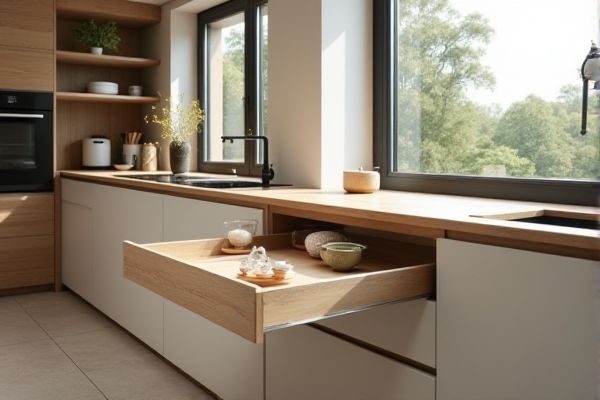
Folding tabletops offer flexible space-saving solutions by easily collapsing when not in use, while pull-out countertops slide out smoothly to extend your existing workspace without clutter. Discover which option best suits your kitchen needs and maximizes your efficiency by reading the rest of this article.
Table of Comparison
| Feature | Folding Tabletop | Pull-Out Countertop |
|---|---|---|
| Design | Hinged surface folds down when not in use | Slide-out surface stored beneath main countertop |
| Space Efficiency | Compact, saves space by folding flat | Maximizes space by sliding out only when needed |
| Installation | Simple, requires wall or cabinet mounting | More complex, involves drawer-type sliding mechanism |
| Durability | Depends on hinge quality, moderate weight support | Sturdy with reliable slides, supports heavier loads |
| Usage | Ideal for occasional, quick surface expansion | Best for frequent use and heavier tasks |
| Cost | Generally lower cost, simpler materials | Higher cost due to hardware and installation |
| Maintenance | Low maintenance; hinges may need lubrication | Requires occasional track cleaning and lubrication |
Understanding Folding Tabletops and Pull-Out Countertops
Folding tabletops provide a compact solution by folding down when not in use, maximizing your space without permanent installation. Pull-out countertops slide out smoothly from existing cabinetry, offering additional surface area that can be easily retracted to maintain a streamlined kitchen layout. Understanding these options helps you choose the best fit for your space efficiency and design preferences.
Space-Saving Benefits Compared
Folding tabletops maximize space efficiency by allowing surfaces to be collapsed flat against walls when not in use, freeing up valuable floor area in compact kitchens or workspaces. Pull-out countertops, integrated within cabinetry, slide out only when needed, providing a seamless and hidden extension that preserves existing countertop space without permanent bulk. Both solutions enhance small-area functionality, but folding tabletops offer more versatility for variable-sized work areas, while pull-out countertops excel in maintaining streamlined aesthetics.
Installation Processes: What to Expect
Folding tabletops require simple wall-mounted brackets and hinges for a straightforward installation that can be completed in a few hours with basic tools. Pull-out countertops involve installing sliding mechanisms and a sturdy support frame, often requiring precise measurements and more advanced hardware. Your choice impacts the complexity of the installation process, with folding tabletops generally being quicker and less labor-intensive compared to pull-out countertops.
Durability and Material Options
Folding tabletops typically offer durable materials such as solid wood, metal, and high-density MDF, designed for frequent adjustments without compromising stability. Pull-out countertops often utilize similar materials but focus on smooth sliding mechanisms that require reinforced hardware to maintain durability over time. Both options provide customizable surface finishes like laminate, natural stone, or engineered composites, influencing longevity and resistance to wear.
Aesthetic Appeal and Design Integration
Folding tabletops offer a sleek, minimalist aesthetic that seamlessly integrates into contemporary interiors, preserving clean lines and maximizing space when not in use. Pull-out countertops, while equally functional, tend to create a more dynamic visual with their hidden sliding mechanisms that can complement modular kitchen designs. Both options enhance design flexibility, but folding tabletops excel in maintaining an uncluttered, streamlined look that appeals to modern minimalist decor.
Cost Comparison and Budget Considerations
Folding tabletops generally offer a more budget-friendly option with lower material and installation costs compared to pull-out countertops, which often require complex mechanisms and custom cabinetry. Your choice impacts long-term value since pull-out countertops may provide greater durability and seamless integration, but at a higher upfront investment. Considering your kitchen layout and frequency of use will help balance cost efficiency and functionality for optimal budget management.
Suitability for Different Spaces
Folding tabletops are ideal for small kitchens and compact dining areas where saving space is crucial, as they can be easily folded down when not in use. Pull-out countertops suit narrow kitchens or galley layouts by providing extra workspace only when needed, without permanently occupying floor space. Both options maximize functionality in limited spaces but cater to different spatial dynamics and user preferences.
Maintenance and Cleaning Tips
Folding tabletops require regular inspection of hinges and joints to prevent rust and ensure smooth operation, making lubrication and tightening essential steps in maintenance. Pull-out countertops benefit from routine cleaning of sliding tracks to avoid debris buildup that can hinder movement, and surfaces should be wiped with mild detergent to maintain hygiene. Both designs demand prompt attention to spills and stains to preserve material integrity and prolong lifespan.
User Experience and Convenience
Folding tabletops offer a space-saving solution that allows you to quickly expand your working area and then retract it when not in use, enhancing your room's versatility. Pull-out countertops provide effortless extension with smooth sliding mechanisms, ensuring consistent stability and ease of access during food preparation or other tasks. Both options improve functionality, but folding tabletops excel in compact spaces while pull-out countertops deliver seamless integration and straightforward usability.
Choosing the Best Option for Your Needs
Choosing between a folding tabletop and a pull-out countertop depends on your space availability and usage frequency. Folding tabletops offer compact storage and are ideal for small kitchens or temporary workspaces, maximizing floor area when not in use. Pull-out countertops provide seamless integration and extra prep space, perfect for those needing quick access without compromising kitchen aesthetics.
 homyna.com
homyna.com